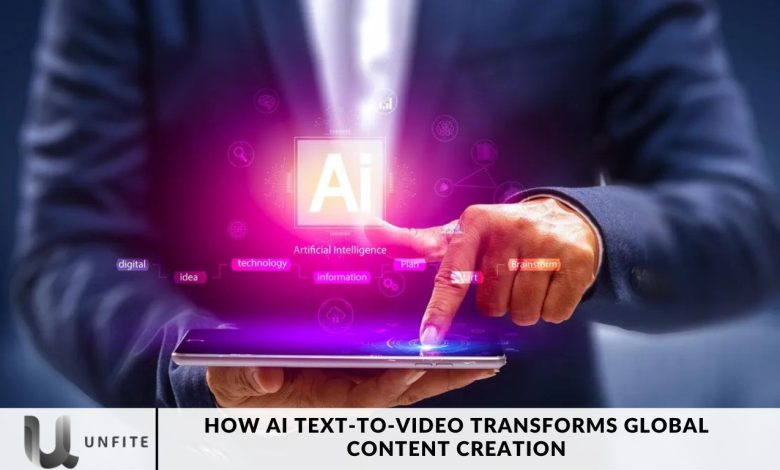How AI Text-to-Video Transforms Global Content Creation

In the rapidly evolving digital landscape, content creation has become one of the most powerful tools for brands, businesses, and individuals to connect with audiences around the globe. Whether it’s educational material, promotional campaigns, or entertainment, video content reigns supreme in its ability to engage viewers across diverse demographics. However, with the increasing demand for multilingual content to cater to different regions and languages, content creators often face the daunting task of producing videos in multiple languages. This is where AI text-to-video technology steps in, revolutionizing global content creation by making it easier to localize and convert written content into videos across various languages.
In this blog, we’ll explore how AI text-to-video is transforming global content creation, the role of localization in reaching diverse audiences, and how businesses, educators, and creators can harness this technology to expand their reach worldwide.
The Growing Importance of Video Content in a Global Market
Video content has emerged as one of the most effective mediums for conveying messages, whether for marketing, education, or entertainment. According to statistics, people are more likely to engage with video content than with text or static images. Videos are more dynamic, visually appealing, and capable of evoking emotions, making them an essential tool for any content creator. However, as businesses expand into international markets, the challenge of creating engaging videos in different languages arises.
While traditional methods of video production are time-consuming and resource-intensive, the emergence of AI-driven tools has simplified the process. AI text-to-video solutions can take a script in one language, convert it into a video, and localize the content for different regions, breaking down language barriers and enabling global communication.
What Is AI Text-to-Video Technology?
At its core, AI text-to-video technology uses advanced machine learning algorithms and natural language processing (NLP) to convert written text into video format automatically. These tools allow users to input a script, select visuals, and generate a video without the need for complex editing software or technical expertise. In addition to creating videos from text, some AI tools also have the capability to localize the content by translating the script into different languages and adjusting the visuals to suit the cultural context of the target audience.
By combining NLP, text analysis, and computer vision, AI text-to-video tools enable creators to transform written content into engaging video content within minutes. This technology is particularly useful for content creators who need to produce videos quickly, consistently, and in multiple languages to cater to their global audiences.
How AI Text-to-Video Enhances Localization Efforts
Localization is the process of adapting content to suit the linguistic, cultural, and regional preferences of a specific audience. When expanding into new markets, localization is essential for ensuring that the message resonates with local audiences and is culturally appropriate. With AI text-to-video technology, localization becomes more accessible and efficient, enabling content creators to scale their efforts globally without compromising on quality or consistency.
Here’s how AI text-to-video supports localization and helps convert written content into multilingual videos:
1. Automatic Translation of Scripts
One of the primary ways AI text-to-video enhances global content creation is through automatic script translation. AI-powered tools can take a written script in one language and translate it into multiple languages with a high degree of accuracy. This eliminates the need for human translators and speeds up the localization process.
For example, a business that creates a promotional video in English can easily translate the script into Spanish, French, or Mandarin using AI text-to-video software. The translated script is then integrated into the video, allowing the brand to reach audiences in different linguistic regions without creating separate videos from scratch.
2. Text-to-Speech Technology for Multilingual Narration
Text-to-speech (TTS) technology plays a crucial role in localizing videos generated from text. AI-powered text-to-video tools often incorporate TTS systems that support multiple languages, enabling creators to provide narration in the native language of the target audience. These systems use AI voices or voice cloning to narrate the translated script, ensuring the video sounds natural and professional.
Advanced AI TTS systems can even mimic regional accents, pronunciation nuances, and tones, allowing businesses to deliver authentic-sounding content. For instance, an educational video targeting a Latin American audience can have narration in a neutral Spanish accent, while a similar video targeting Spain may have a distinct Castilian accent.
3. Customizing Visuals to Suit Regional Preferences
While translating the script and adding localized narration is important, cultural nuances also play a significant role in video content creation. AI text-to-video tools have the ability to adjust visual elements based on regional preferences. This could include changing color schemes, clothing styles, or even the appearance of characters to align with the cultural norms of the target audience.
For example, a brand creating a marketing video for the U.S. and Middle Eastern markets may choose to feature diverse characters that represent the cultural background of each region. AI tools can analyze the cultural context and make these visual adjustments seamlessly, ensuring that the content feels relatable and inclusive to different audiences.
4. Adapting Content for Different Social Platforms
Another advantage of AI text-to-video tools is their ability to adapt content for various social media platforms across regions. Different countries and regions have their own popular social platforms, and each platform may have specific video requirements. For example, vertical videos may perform better on Instagram and TikTok, while landscape videos may be more suited for YouTube.
AI tools can automatically format and adjust videos to fit the requirements of different platforms, ensuring that the content is optimized for maximum engagement on a global scale. This feature is especially useful for businesses running international campaigns that need to maintain a consistent message across multiple platforms.
Real-World Applications of AI Text-to-Video in Global Content Creation
AI text-to-video technology is already transforming content creation in various industries. Below are a few real-world applications where AI text-to-video is making a significant impact on global content creation:
1. E-Learning and Educational Content
Educational institutions and e-learning platforms are using AI text-to-video tools to create multilingual courses and learning materials. These tools allow educators to quickly generate video lessons in multiple languages, making education more accessible to students from different linguistic backgrounds. With AI text-to-video technology, educational content can be easily localized to suit the language preferences of learners, creating a more inclusive and effective learning experience.
2. Marketing and Advertising
Global brands are leveraging AI text-to-video tools to create localized marketing and advertising campaigns. Instead of producing multiple versions of the same video for different regions, brands can use AI to translate the script, adjust the visuals, and generate videos for various markets in a fraction of the time. This not only saves resources but also ensures that the brand’s message remains consistent across languages and regions.
3. Social Media Content Creation
Social media influencers and creators are increasingly turning to AI text-to-video tools to generate videos in multiple languages. This enables them to engage with a more diverse audience and increase their reach on platforms like YouTube, TikTok, and Instagram. By using AI, creators can quickly produce content in various languages without the need for manual translation or video editing, allowing them to scale their content efforts globally.
The Future of AI Text-to-Video in Global Content Creation
As AI technology continues to evolve, the capabilities of text-to-video tools will become even more sophisticated. Future advancements may include real-time translation and video generation, allowing creators to produce localized videos on the fly. AI tools may also become more intuitive, with enhanced cultural sensitivity features that automatically adjust content for different regions without requiring manual input.
Moreover, as AI text-to-video tools become more accessible, businesses of all sizes will be able to harness this technology to create high-quality, localized videos, making global content creation more efficient and affordable.
Conclusion
AI text-to-video technology is revolutionizing the way content is created and localized for global audiences. By streamlining the process of converting written content into videos and supporting multiple languages, AI text-to-video tools are helping businesses, educators, and content creators break down language barriers and expand their reach worldwide. With the ability to automatically translate scripts, provide multilingual narration, and customize visuals for different regions, AI is transforming global content creation, making it easier than ever to engage audiences across the globe.




